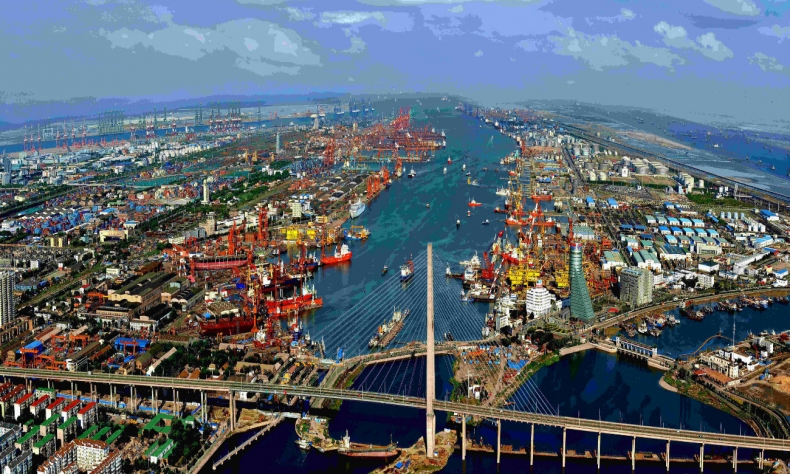Slow and Steady Does it for the Chinese Economy in 2018: Be Alert that Elephant Trump is in the Room

This year, Chinese economic growth is expected to slow slightly as the government continues to lay the necessary groundwork for a new economy, emblematic of a China Dream, where qualitative growth and sustainability are free to flourish.
This year, Chinese economic growth is expected to slow slightly as the government continues to lay the necessary groundwork for a new economy, emblematic of a China Dream, where qualitative growth and sustainability are free to flourish. With that said, the GDP-centric growth models of the past still live on, as leadership tries not to lose sight of the 2020 growth target of doubling real GDP on the basis of 2010.
In keeping with these aims, China looks to simplify and reduce its tax code, as well as strip various industries of different forms of red tape which are viewed as an obstacle to maintaining the nation’s competitiveness in the global economy. The country will however, have to be alert to the economy’s nagging debt issue, along with the growing protectionist impulses of an increasingly unstable and uncertain Trump administration, when assessing and managing growth for 2018.

On March 5th, the first session of the 13th National People’s Congress kicked off with Premier Li Kejiang delivering a work report highlighting the government’s economic achievements over the last few years, which also went about underpinning the different measures government plans to adopt to help ensure continued prosperity for the world’s most populous nation. Premier Li announced that the real GDP growth target for 2018 will be about 6.5 percent, with an inflation(CPI) target of 3.0 percent. Premier Li also pledged to cut taxes on firms and individuals by $800 billion this year, mainly by simplifying China’s value added taxes and pursuing the option of reducing import charges for the manufacturing and transport industries.
Restrictions on foreign investment and trade in the telecommunications, medical care, education and financial sectors, among others will also be loosened in a bid to retain China’s position as a top destination for foreign capital around the world.
China Acts Swiftly to Maintain Competitiveness
They can also be avoided with the right amount of foresight and diligence. As previously alluded to, China, in the wake of the recent reductions made to income and corporate taxes by the Trump administration, has been forced to somewhat react in kind by cutting some of their taxes in order to maintain competitiveness in the global markets and prevent an exodus of foreign capital.
Thus, while a tax goodie of $800 billion would normally act as a significant stimulus to the economy, estimates on how much it might contribute to growth in 2018 are still up for debate. As the move itself is mostly reactionary in nature and has left China playing a game of catch-up, where the retention of capital has taken priority over the attainment of new, additional investment.

On top of that, there is also the constant presence, the elephant in the room that is all things Trump. Consistently low approval ratings and mounting pressure coming from the Mueller investigation into the president and any potential, illegal links with the Kremlin have arguably spawned a less predictable, and increasingly bizarre Trump administration. And as the sight of departing high level cabinet officials (most recently US Secretary of State Rex Tillerson) makes a return to our tv screens and Twitter feeds, US protectionist urges reach their overture with America having imposed new tariffs on steel and aluminum imports earlier this month. The USA has now signed this into law, as import tariffs of 25 percent and 10 percent for steel and aluminum (respectively) have now been sanctioned. In a move which harkens back to the steel tariffs imposed by President George W Bush in 2002, recent US protectionist measures should represent a cause of concern for China. Albeit, not in the way that many would expect.
The effects that heightened import restrictions on steel and aluminium in the USA will have on China are negligible. Despite China being the world’s largest producer of steel and aluminium by far, contrary to popular belief, the nation’s share of US steel imports for example, is quite modest at just over three percent, according to data gathered by Wood Mackenzie. Indeed, data from the Commerce Department suggests that China barely scrapes its way into the top ten for US steel imports.
More important are the implications such a move sends out regarding the future of trade in America and the rest of the world. It would seem as if the USA, under the auspices of the Trump administration, has been executing recent protectionist measures with an eye to implementing a grand, overall strategy: a strategy which is derived from the US government’s America First doctrine, that focuses on turning back the clock on the nation’s manufacturing sector for reasons of safeguarding employment and protecting, what is viewed to be, the interests of national security. As touched on in a previous article of mine in ‘A Changing Relationship for a New Economic and Political Age’, these recent tariffs are one of the many different measures that have been pursued by the Trump administration as a means to redressing its large trade deficit with the rest of the world. It also probably won’t be the last.
More Tariffs?
As we speak, President Trump is renegotiating the NAFTA trade agreement between the other member states of Canada and Mexico. He is also reportedly exploring the option of imposing tariffs on up to $60 billion of Chinese imports. It is rumored that the US government is considering this new set of tariffs on the basis of a ‘Section 301’ intellectual property investigation currently being carried out under the 1974 US Trade Expansion Act.

The protectionist measures would specifically target the technology and telecommunication industries of China, both sectors (technology in particular) that the country has experienced a lot of growth and innovation in, as they become increasingly more important drivers of development in a more mature economy which is moving away from the Made in China age to a future anchored in an upgraded, Created in China economy. If this investigation happens to be followed up on with more of the same surrounding recent American attitudes to global trade, then this would really hold the potential to compromise China’s ability to meet its growth target of 6.5 percent this year.
Nevertheless, it must also be remembered that China does plan to relax a number of duties and tariffs for foreign imports, as well as open up more domestic sectors to FDI, with this potentially being enough to bring some calm to the US’s protectionist behavior and stop America short of imposing any further restrictive acts surrounding trade and commerce on China and the rest of the world.
Furthermore, in the case that more tariffs were actually imposed on Chinese exports, the impact that it could have on China’s wider economy is still up for debate in respect to its magnitude. According to figures from the World Bank, exports as a percentage of total GDP in China are now just shy of 20 percent, significantly down from an all-time high of 37 percent in 2006.
The latest data for exports as a total percentage of GDP also serve as an indicator of the progress made by China in restructuring its economy into one more reliant on domestic consumption and development, as Chinese exports as a share of total GDP have not been this low since 1999, a full two years before the country’s accession into the World Trade Organization (WTO).
Onwards and Upwards for China
As also noted in the government report delivered by Premier Li Keqiang early last week, the government is set to spend over $500 billion on infrastructure development across the nation.

As hundreds of billions of dollars are spent on roads, water management and railways, this is sure to provide the economy with a stimulus strong enough to help China reach, or even exceed its 2018 growth target of 6.5 percent. And while some point to China’s reduction of its fiscal deficit target, from 3.0 percent last year to 2.6 percent this year, as an indicator of an overall deceleration of government spending in China, which could in turn suggest weaker growth prospects for the nation, this suspicion is yet to be confirmed.
In fact, a closer look at the numbers may suggest the opposite. China’s total tax revenue for the year of 2017 saw double digit growth for the second year in a row, as it increased by 10.7 percent to ¥14.4 trillion, implying that any predicted fall in the deficit will likely be as a result of increased tax receipts rather than relatively less spending. Of course, announced tax reforms may slightly dampen growth figures for China’s total tax revenue in 2018, but whether it would slow down enough to the point where it would mean that the 0.4 percent reduction in the deficit would occur as a result of tightened fiscal spending, seems unlikely.
While the nation is still focused on meeting its 2020 growth target, Premier Li’s government report on the economy also signaled China’s growing desire to move to an economic model which is focused on qualitative growth, as the country bides its time and continues to make incremental changes to its economic structure. It would seem as if China is on course to meet its targets, but in doing so, it must be sure to pay attention to any potential changes regarding its trade relationship with other nations. An increasingly unpredictable world always has the danger of rendering predicted paths irrelevant.
Timothy Lobban BA (Cantab)
Previously copy edited for china.org.cn, also ChinaFocus’ columnist
The article reflects the author’s opinion only, and not necessarily the view of China Focus
 Facebook
Facebook
 Twitter
Twitter
 Linkedin
Linkedin
 Google +
Google +







